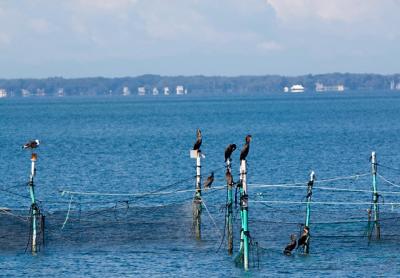Nature Notes: No Way Out

September is not only back-to-school month, it is also the end-of-harvest month and fish-after-fish month. It is the time of the great migration: birds, fish, whales, and even butterflies and darning needles are winging it south. If you’re a sportfisherman, you are out for stripers as they round Montauk Point. If you make a living catching fish and shellfish, you are raking clams, setting gill nets and purse seines, and tending to your fish traps.
Pound nets, a particular type of fish trap, consisting of hardwood poles, a leader net strung perpendicular to the shore on those poles, with a pound trap at the very end, farthest from shore, have been used in these parts for hundreds of years now. Fish hit the leader net as they swim along and it leads to the pound. Once they swim in, they can’t swim out. It’s one way of making a living and providing fresh fish to the community. To be a successful pound net fisherman, you just have to faithfully tend to your traps on a daily basis and get your catch to market while it’s still fresh.
Fish traps come in a variety of forms, some made of rocks, some of vegetative stalks and branches, and some composed of nets and stakes. Some have been traced back to well before Christ by carbon-dating pieces of wood that were used in their construction. In this country, native peoples along most coasts and most rivers relied on fish traps for most of their protein. European settlers in East Hampton learned from the Shinnecocks, Montauketts, and Corchaugs, who made pound traps with stakes and meshes of vegetation stuck in the sands of tidal creeks and shallow bays.
Once a pound trap in a particular area is found to be productive, it might be installed at that very spot on an annual basis for more than 50 years running. On the North Fork many fish traps in the Peconics, especially those east of Greenport, were often erected and maintained by potato farmers. Indeed, the famous self-taught Long Island naturalist and archaeologist, Roy Latham, maintained one or more with his brother, a potato farmer, off Orient and East Marion.
On old United States Coast Survey maps covering the Peconic Estuary, one can see short “lines” running perpendicular to the shore out into the water for 100 or more feet. These lines represented pound traps. A few current-day traps are found in almost the same spots, say off Gerard Drive on Gardiner’s Bay, off the tip off Barcelona in Northwest Harbor, in Fort Pond Bay off Montauk, and in Gardiner’s Bay near the mouth of Fresh Pond in Amagansett.
Fish traps not only provide fresh fish for people to consume, they are great perching and roosting spots for a variety of water birds including cormorants, ospreys, terns, and gulls that also rely on a diet of fish. Just a week ago I stopped on the bay side of Long Beach Road in Noyac to count the number of birds perched on the nets and poles of a pound net there, in a spot where one has been established for at least a decade. There were 33 cormorants, adults and young, three common terns, and a black-backed gull. Two osprey young of the year were atop the nest on the utility pole at the foot of the trap taking in the scene while an adult osprey (a parent?) glided back and forth overhead. An idyllic scene, almost pastoral!
They had either fed or were waiting to feed, and remained quiet and motionless while I counted and photographed them. In another couple of weeks they would be heading south.
That peaceful seascape with its assemblage of water birds reminded me of others in my past. I thought how wonderful it must be for those who work the nets to see what they collected and experience the pleasure of working on the water, instead of sitting in a stuffy office or standing behind the counter at a big box store. These fishermen know something intimately that very few of us nonfishermen know. They are as close to the watery realm in spirit and occupation as the very birds that quietly line their traps.
Larry Penny can be reached via email at [email protected].
